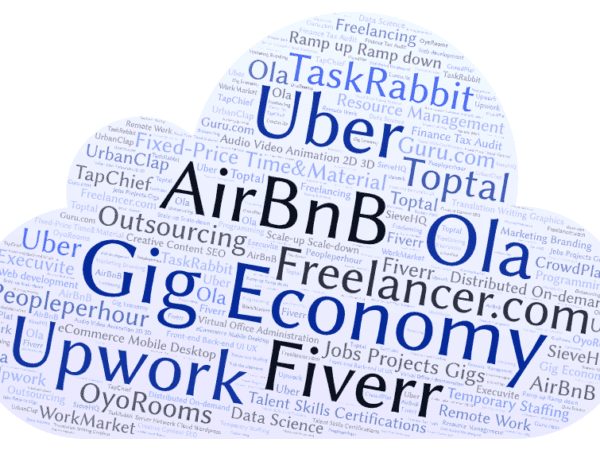GigsBoard is not just a Freelancing platform.
GigsBoard has been custom-built to overcome several of the key gaps in traditional Freelancing – Adding processes and tools to drive eliminate expectation mismatches, enable transparency of status, boost alignment across the project team, and drive up overall predictability of success of the projects executed.
Read on to learn how we’re different from the crowd.
The big issue with Freelancing
Traditional Freelance platforms have been around for many years, and are mostly very simple & intuitive.
And as reported by many Industry leaders & Market researchers, the Freelance industry is booming.
However, key gaps in functionality coverage drive certain behaviours in many Freelance platforms:
- While numbers of Freelancers as well as number of Freelance Jobs are increasing, the typical ticket size (contract price) is still not increasing correspondingly.
- We believe that when Job Ticket sizes increase, the propensity is to Outsource that Job, rather than Freelance it.
- We also believe that the primary reason for this attitude is the overall lack of trust in Freelance platforms.
- Many Customers do not completely trust Freelancers especially with their large/ mission-critical projects;
- Many Freelancers do not completely trust Customers to pay the full contracted amount in a timely manner.
What do typical Freelance platforms bring to the table?
Most Freelance platforms provide the following standard features:
- A Talent pool, that covers a variety of Work Domains (Eg: IT, Data, Graphics, Content, etc), and Skills (Eg: In IT, this could be WordPress, Java, PHP, Python, etc).
- A Talent Discovery mechanism. Each User will be able to build a Resume & showcase their capabilities to potential users, and thus be searchable via the platform.
- A Contracting framework where Customers can: Publish their Jobs; Receive Job Proposals from Service providers (Freelancers or Agencies); Compare the proposals; Award the Job to the most suitable Service provider; Establish a milestone plan for deliveries & payments; and Enter into a Contract with the awarded Service Provider.
- A Collaboration mechanism for both parties to communicate.
- A Delivery mechanism for Service Providers to submit their products, and for the Customers to review and accept/ reject the products.
- An Escrow-based Invoicing-and-Payments mechanism, and
- A Performance feedback mechanism, where both parties can submit their Satisfaction ratings & feedback against the other party.
Some Freelance platforms go further, and enable other features, like:
- Vetting of Freelancers on Skills.
- Vetting of Service provider Agencies.
- Verified reviews of Freelancers.
- Service Providers can band & operate as a Team, to work on a ‘larger’ project.
- AI-enabled Requirements definition.
- AI-enabled Estimations.
- Management oversight by the Platform team, etc.
Perceived shortcomings in typical Freelance platforms
- Expectations management: Typical Freelance platforms have a text-based Requirements capture mechanism in place. Further, “Acceptance criteria” cannot be efficiently defined in a structured & traceable manner. These lead to confusion, disagreements, and disputes about scope, as project execution progresses.
- Change control: Most projects undergo some evolution in Requirements as project execution progresses. Given the lack of effective Requirements management tools, this compounds the problem with Customer Expectations management.
- Estimates definition: The building of project estimates is highly dependent on the level of skill & structured approach applied by the Service provider. Hence the likelihood that a submitted Estimate has missed or under-/ over-estimated on certain project components is high. This can even lead to project abandonment by the service provider later on.
- Proposals prioritization: Most Freelance platforms allow Customers to sort Job Proposals received on the basis of one of two factors: Proposal price, and Average Freelancer Rating (or Performance score). The inadequate sorting basis may lead to price wars as Service providers resort to Price undercutting to get their Job Proposals included in the top “X” proposals.
- Contracting cycle: Given the lack of structure in Requirements definition and in the Job Proposals definition, there is a high possibility of long-drawn out phase for building a comparative analysis of the received Job proposals, followed by multiple back-and-forth requests for ‘additional data collection’, etc. This leads to an unpredictable length of time spent from Job publishing to the Job award & contracting.
- Detailed planning: The lack of structure in Expectations management, along with the dependence on the individual skills in detailed planning, leads to potential of ineffective detailed planning, specially for large projects. This could lead to project delays/ failures and disputes later on.
- Deliverables rejection: Due to the lack of in-depth definition of Acceptance criteria, there is potential for Customers & Service providers to translate Project components differently, and leading to the potential for adhoc rejection of product components by the customer.
- Payment delays: While the Escrow mechanism forces Customers to credit payments against invoices, there is nothing that enforces a timely payment by the Customer to escrow, nor a timely settlement and release of due payments to the Service provider.
- Performance ratings: Performance rating submissions are very subject to biases by the Users submitting the ratings – cultural/ societal-driven, attitude-driven, and emotional state-driven. This can lead to issues with Talent discovery when these Assessment values are applied to generate relative ratings.
How GigsBoard overcomes these shortcomings
- Agile-enabled Requirements management engine, to capture & publish a structured Jobs, and to capture unambiguous Acceptance criteria.
- Built-in tool for structured Estimates development, to ensure the development of comprehensive, traceable estimates.
- Automated tool for comparison of Job Proposals, to drive efficiency & speed in the Proposals-to-Job Award journey.
- Templatized Contracting engine to ensure that contracts are unbiased & SLA-driven.
- Automated detailed Project planning tool to drive best practices into Project planning.
- Agile-based Project Management engine, to enable Cycles-based Project execution and high-granularity project control at all times.
- Kanban-based Visual project management for 1-click visual project management, while enabling deep-dives into “Red/ Amber” projects as needed.
- Agile-enabled automated Financial management system, to implement an effective & win-win Pay-as-you-go mechanism.
- Automated Performance management system, to eliminate biases in Performance assessments.
- Intelligent Project Governance engine, to offload the burden of data-driven project management from Project Managers to the Platform itself.
With these functions, GigsBoard aims to drive:
- Clarity and end-to-end traceability of scope
- Transparency of project status
- Team alignment on work components and status; and thus
- Drive trust across users.
Wrap-up
With all of the built-in mechanisms in the platform, GigsBoard is targeting various objectives, such as:
- 100% clarity and traceability of scope
- Upto 40% reduction of project duration
- Upto 45% reduction in impact of change control
- Upto 60% reduction of project budget
- Along with overall improvement of trust & win-win across all contract users.
The end objective being: Opening up Platforms for IT Outsourcing of large projects, and systemically making project execution more predictably successful & always-in-control.
We call this model OAAS – Outsourcing-as-a-Service.
Welcome to the new world of Freelancing & Outsourcing!
Additional notes
If you would like to learn more about how exactly we do this, then we would like to invite you to watch this YouTube video.
And if you would like to interact & brainstorm with us about GigsBoard, we would love to invite you to register for a Product Intro webinar at your convenience.



